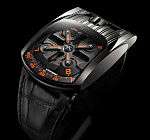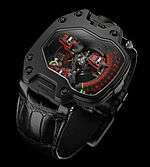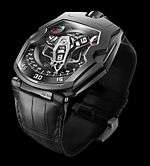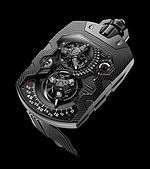Urwerk
|
| |
| Private | |
| Industry | Watchmaking |
| Founded | 1995 |
| Headquarters | Geneva, Switzerland |
Key people | Felix Baumgartner and Martin Frei |
| Products | Watches |
| Website |
www |
URWERK is an award-winning watch brand based in Geneva, Switzerland, known for its avant-garde designs and new indications and complications. URWERK was founded in 1995 by watchmaker brothers Felix and Thomas Baumgartner and artist Martin Frei (Thomas Baumgartner left in 2004). They presented their first timepiece with the Academy of Independent Watchmakers (AHCI) at Baselworld in 1997. The URWERK collection has grown to include several series of timepieces including the 110, the 103, the 200, the 1001 and LAB. The UR-110 was awarded the prize for ‘Best Design Watch[1]’ at the 2011 Grand Prix d'Horlogerie de Genève. URWERK also created the Opus V for Harry Winston.[2]
Name
The name URWERK is a play on the German word ‘Uhrwerk’, meaning ‘clockwork’. The ‘Ur’ in URWERK’s name refers to the ancient Sumerian city of Ur where over 6,000 years ago people used giant sundials to measure time; the ‘werk’ refers to the German noun ‘das Werk’ meaning ‘work’ or ‘creation’.
Collections

UR-103: The UR-103 features URWERK's revolving satellites complication, with four domed satellites hosting three hour numbers each. On the back of the case is a control board with functions: power-reserve indicator, 15-minute and 60-second dials for precise time setting and fine adjustment screw.

UR-110:The UR-110 displays time on the right side of the watch so the time is easily visible under a cuff. The rotating hour satellites satellite complication and mounted on planetary gears and follow a vertical line graded from 0 to 60 minutes in a downward motion. Other features include “Day/Night” and "Oil Change" indicators as well as small seconds. On the back, the automatic winding system is regulated by dual air turbines.

UR-202/203: The UR-202/203 employs the URWERK signature satellite complication. This time telescopic minute hands, operating through three orbiting and revolving hour satellites, adjust their length to follow the three vectors (0-14, 15-44, 45-60) signalling minutes. The back of the UR-202 features a winding system regulated by compressing air using miniature turbines. The UR-202 is available in red gold, white gold, black PE-CVD platinum and ALTiN. The case of the UR-202 Édition Spéciale features an art deco engraving by Jean-Vincent Huguenin while the UR-202S, in steel or ALTiN, features a metal strap.

UR-210:The UR-210 features the world's first 'winding efficiency indicator,[3] which displays winding efficiency over the last two hours so that the wearer knows if they are adding or subtracting energy from the automatic winding mechanical movement. On the back is a winding efficiency selector switch that enables the user to adjust the winding efficiency of the winding mechanism by altering the amount of compression in the miniature air turbines.

UR-1001: The UR-1001 Zeit Device was URWERK’s first pocket watch and features 10 complications and indications: Satellite hours, retrograde minutes, day/night indicator, running seconds, power reserve indicator, revolving satellite calendar displaying months on the dial side plus date, oil change indicator, 100-year indicator and 1000-year indicator on the display back. The AlTiN UR-1001 Zeit Device is a limited edition of eight pieces in AlTiN-treated steel with titanium elements.

LAB: The LAB collection includes the UR-CC1, featuring yellow jumping hours and retrograde minutes on a black anthracite background at 6 o’clock. The hours and minutes move linearly and in parallel from left to right. Seconds are indicated at 12 o’clock via a rotating disc that gives both a digital and a linear display. Visible through a window on the side of the case is the pneumatic shock-absorbing Rotor Fly Brake automatic winding system, which minimises rotor and mechanism wear and damage from shock and extreme movements.T2007 Launch of their newest watch model "201" at Geneva Fairs. Time on the "201" is displayed by using telescopic minute hands operating through the middle of three orbiting and revolving hour satellites. The telescopic minute hands precisely adjust their length to follow the three vectors marking the minutes: 0–14, 15–44, 45–60. Extended, they enable the 201 to display the time across a large, easy-to-read dial. Retracted, they allow for a very wearable sized case, thus providing the wearer with both capabilities.
Collaborations
Opus V for Harry Winston. The presentation of the UR-103 at Baselworld 2003 raised URWERK’s profile, attracting the attention of Harry Winston Rare Timepieces, for example. Soon URWERK were asked to create the Opus V for Harry Winston, beginning development in 2004. It was presented a year later. The Opus V incorporates URWERK’s signature hour display with three rotating blocks adorned with numbers on each side to indicate hours against a vertical and arced line marked 0-60 on the left-hand side of the dial to indicate minutes. The Opus V has a power reserve indicator, day/night indicator and, on the back, a service indicator to tell the owner when the timepiece needs to be serviced, in this case every five years. The Opus V’s crown protector is in a ‘gull-wing’ style. This timepiece was presented in pink gold; in platinum; in platinum with full cut diamonds; and in platinum with baguette cut diamonds.
Felix Baumgartner and Martin Frei

Felix Baumgartner was born in Schaffhausen, Switzerland in 1975 into a family with a history of watchmaking. In 1991 he enrolled at the Solothurn watchmaking school. On gaining his watchmaking diploma in 1995, Baumgartner moved to Geneva to work as an independent watchmaker and developed complicated watches, including perpetual calendars and minute repeaters as well as restoration commissions for a variety of brands. It was shortly afterwards that Baumgartner met Martin Frei while in Zurich and (with Felix's brother, Thomas) they founded URWERK.
Martin Frei was born in Winterthur, Switzerland in 1966. Frei’s father was an engineer while his mother was his first art teacher. In 1987, Frei gained a Diploma in Graphic Design from the School of Visual Arts, Zurich. Two years later, he obtained a Bachelor of Arts at the Hochschule für Gestaltung und Kunst (School of Art and Design) in Lucerne where he was a student of Swiss artist Roman Signer. In 1990, Frei completed a one-year course on Video and Film at the same Lucerne design-art school. In 1994 in Lucerne, Frei founded U.S.A. (United Swiss Artists), creating videos and putting on exhibitions and performances. A year later while in Zurich, Frei met Felix Baumgartner and (with Felix's brother, Thomas) they founded URWERK.
Awards
[4] In 2011, URWERK’s UR-110 was awarded the prize for ‘Best Design Watch[1]’ at the Grand Prix d'Horlogerie de Genève. The UR103T Tarantula won top prize in the category of Best Sports Watch [4] at the 2009 Grand Prix d'Horlogerie Asia competition. URWERK also won the Best In Design category at the same awards for the URWERK CC1.
References
External links
- Urwerk website
- Urwerk on Steroids — Titanium Aluminum Nitrade Coated 103.08
- Urwerk Watches—The birth of the company, and the collections it launched
- Back To The Future: The Urwerk UR-105M by Ian Skellern on Quill & Pad